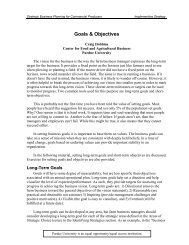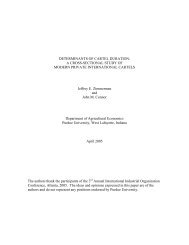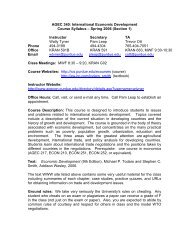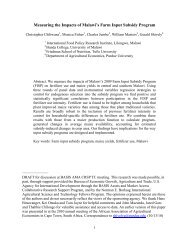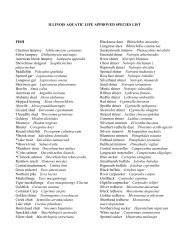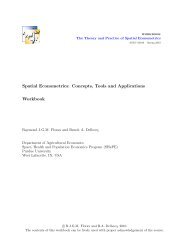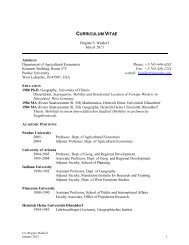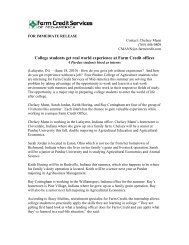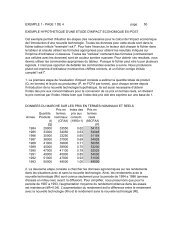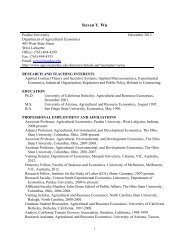The What, Why, Where, When, and How of New Generation ...
The What, Why, Where, When, and How of New Generation ...
The What, Why, Where, When, and How of New Generation ...
You also want an ePaper? Increase the reach of your titles
YUMPU automatically turns print PDFs into web optimized ePapers that Google loves.
<strong>New</strong> <strong>Generation</strong><br />
Cooperatives: <strong>What</strong>, <strong>Why</strong>,<br />
<strong>Where</strong>, <strong>and</strong> <strong>How</strong><br />
An Internet Guide<br />
Michelle Schank <strong>and</strong> Joan Fulton<br />
Michelle Schank is a Graduate Research Assistant <strong>and</strong> Joan Fulton is an Associate<br />
Pr<strong>of</strong>essor in the Department <strong>of</strong> Agricultural Economics<br />
As consolidation <strong>and</strong> the industrialization <strong>of</strong> agriculture intensify, the food chain is<br />
experiencing significant structural changes. Increased concentration <strong>and</strong><br />
increased vertical coordination are occurring as businesses in the agrifood sector<br />
are trying to increase efficiencies, relay information along the supply chain more<br />
quickly, <strong>and</strong> take advantage <strong>of</strong> pr<strong>of</strong>its at other stages <strong>of</strong> the food chain. Many<br />
agricultural producers are responding to the changing environment by cooperating<br />
with other producers to develop value-added businesses. One common<br />
organizational form that producers are using for the value-added business is the<br />
<strong>New</strong> <strong>Generation</strong> Cooperative.<br />
This Internet Guide is intended to be a resource for locating electronically available<br />
information on <strong>New</strong> <strong>Generation</strong> Cooperatives. In the following sections we provide<br />
a brief explanation <strong>of</strong> the <strong>What</strong>, <strong>Why</strong>, <strong>Where</strong>, <strong>and</strong> <strong>How</strong> <strong>of</strong> <strong>New</strong> <strong>Generation</strong><br />
Cooperatives, along with related references to publications <strong>and</strong> other information<br />
that is available on the internet.<br />
<strong>What</strong> is a <strong>New</strong> <strong>Generation</strong> Cooperative?<br />
<strong>New</strong> <strong>Generation</strong> Cooperatives (NGCs) are a relatively new cooperative structure.<br />
NGCs have particular characteristics that differentiate them from traditional<br />
agricultural cooperatives. <strong>The</strong>se characteristics include: value-added processing <strong>of</strong><br />
members’ commodities, a significant equity contribution by farmer members,<br />
obligation <strong>of</strong> product delivery based on equity contribution, <strong>and</strong> the ability to trade<br />
equity shares <strong>and</strong> delivery rights. Two characteristics <strong>of</strong> NGCs that are similar to<br />
traditional cooperatives are: earnings based on member patronage <strong>and</strong> onemember,<br />
one-vote.Fulton et. al. examine the growth <strong>and</strong> development <strong>of</strong> <strong>New</strong><br />
<strong>Generation</strong> Cooperatives along with describing the structure <strong>of</strong> NGCs <strong>and</strong> the<br />
strengths <strong>and</strong> weaknesses <strong>of</strong> this form <strong>of</strong> business. This overview can be found<br />
at:
Fulton, Joan, Brian Jones <strong>and</strong> Lee Schrader. (1998) "<strong>New</strong> <strong>Generation</strong><br />
Cooperatives." Purdue Agricultural Economics Report. September. p.<br />
7-10.<br />
http://www.agecon.purdue.edu/ext/paer/1998/paer0898.pdf<br />
Other useful articles that provide an overview on <strong>New</strong> <strong>Generation</strong> Cooperatives<br />
include:<br />
Hackman, Deanne. (2001) “<strong>What</strong> is a <strong>New</strong> <strong>Generation</strong><br />
Cooperative(NGC)?” Ag Decision Maker. Iowa State University<br />
Extension. December 2001.<br />
http://www.extension.iastate.edu/agdm/articles/others/HackDec01.htm<br />
Coltrain, David, David Barton, <strong>and</strong> Michael Bol<strong>and</strong>. (2000)<br />
“Differences between <strong>New</strong> <strong>Generation</strong> Cooperatives <strong>and</strong> Traditional<br />
Cooperatives.” Arthur Capper Cooperative Center, Kansas State<br />
University. May 2000.<br />
http://www.agecon.ksu.edu/accc/kcdc/PDF%20Files/DiffTrad3.pdf<br />
University <strong>of</strong> Manitoba <strong>and</strong> Agri-Food Research Development<br />
Initiative. (1999) “<strong>New</strong> <strong>Generation</strong> Cooperatives on the Northern<br />
Plains.”<br />
http://www.umanitoba.ca/faculties/afs/agric_economics/ardi/index.html<br />
Fulton, Murray. (2000) “<strong>New</strong> <strong>Generation</strong> Cooperatives.” Centre for<br />
the Study <strong>of</strong> Co-operatives. University <strong>of</strong> Saskatchewan. November<br />
2000.<br />
http://coop-studies.usask.ca/pdffiles/<strong>What</strong>%20Are%20NGCs%3F.pdf<br />
Centre for the Study <strong>of</strong> Co-operatives. University <strong>of</strong> Saskatchewan.<br />
(2001) “Overview <strong>of</strong> NGC Model.”<br />
http://coop-studies.usask.ca/NGC2/ngcoverview.htm<br />
<strong>Why</strong> Do Producers Form <strong>New</strong> <strong>Generation</strong><br />
Cooperatives?<br />
<strong>The</strong>re are many reasons why producers form a <strong>New</strong> <strong>Generation</strong> Cooperative.<br />
Producers may individually be looking for the opportunity to increase their margins<br />
<strong>and</strong> thus their income, diversify their investment portfolio, reduce their risks, or<br />
increase their market. In addition, producers may decide to form a NGC if their<br />
local processing plant closed <strong>and</strong> they needed somewhere to market their<br />
product. Another reason for forming a NGC is to increase or maintain the number
<strong>of</strong> jobs in the local community. Articles can be found on the following websites that<br />
describe some <strong>of</strong> the problems associated with traditional cooperatives along with<br />
an explanation <strong>of</strong> the emergence <strong>of</strong> NGCs.<br />
Cook, Michael <strong>and</strong> Constantine Iliopoulos. (1999) “Beginning to<br />
Inform the <strong>The</strong>ory <strong>of</strong> Cooperative Firm: Emergence <strong>of</strong> <strong>New</strong><br />
<strong>Generation</strong> Cooperatives” <strong>The</strong> Finnish Journal <strong>of</strong> Business Economics.<br />
April. P.525-535. (University <strong>of</strong> Missouri)<br />
http://www.ssu.missouri.edu/faculty/mcook/cv/finnish.pdf<br />
Coltrain, David, David Barton, <strong>and</strong> Michael Bol<strong>and</strong>. (2000) “Value<br />
Added: Opportunities <strong>and</strong> Strategies” Arthur Capper Cooperative<br />
Center, Kansas State University. June 2000.<br />
http://www.agecon.ksu.edu/accc/kcdc/PDF%20Files/VALADD10%202col.pdf<br />
Articles can be found on the following websites that provide further explanation<br />
concerning why individual producers would invest in a NGC:<br />
Sinner, George. (1999) “<strong>Why</strong> Farmers won’t survive unless they<br />
become Food Merchants” Bloomquist Lecture Series. Quentin Burdick<br />
Center for Cooperatives, North Dakota State University. April 1999.<br />
http://www.ag.ndsu.nodak.edu/qbcc/BloomquistLectures/1999sinner.htm<br />
Torgerson, R<strong>and</strong>all. (2001) “A Critical Look at <strong>New</strong> <strong>Generation</strong><br />
Cooperatives” Rural Cooperatives. USDA Rural Business-<br />
Cooperative Service. January/February. P.15-19.<br />
http://www.rurdev.usda.gov/rbs/pub/jan01/jan01.pdf<br />
Cobia, David. (1997) “<strong>New</strong> <strong>Generation</strong> Cooperatives: External<br />
Environment <strong>and</strong> Investor Characteristics” Food <strong>and</strong> Agricultural<br />
Marketing Consortium, Las Vegas, NV. January 1997. (Quentin<br />
Burdick Center for Cooperatives, North Dakota State University)<br />
http://www.wisc.edu/uwcc/info/cobia.html<br />
H<strong>of</strong>str<strong>and</strong>, Don. (1999) “Value-Added Cooperatives – Wave <strong>of</strong> the<br />
Future” Ag Decision Maker. Iowa State University Extension. January<br />
1999.<br />
http://www.exnet.iastate.edu/agdm/articles/h<strong>of</strong>/H<strong>of</strong>Jan99.htm<br />
Articles on the following websites provide information concerning the economic<br />
benefits that communities enjoy when a NGC is established in the region:<br />
Rural Business Cooperative Service. “<strong>The</strong> Impact <strong>of</strong> <strong>New</strong> <strong>Generation</strong><br />
Cooperatives on their Community” USDA Rural Business- Cooperative
Service. Report by a consortium <strong>of</strong> Midwest university researchers.<br />
http://www.rurdev.usda.gov/rbs/pub/RR177.pdf<br />
Sell, R<strong>and</strong>all, Dean Bangsund, <strong>and</strong> F. Larry Leistritz. (2000)<br />
“Contribution <strong>of</strong> the Bison Industry to the North Dakota Economy”<br />
Agricultural Economics Report. Department <strong>of</strong> Agricultural<br />
Economics, North Dakota State University. June 2000.<br />
http://agecon.lib.umn.edu/cgibin/pdf_view.pl?paperid=2288&ftype=.pdf<br />
Doherty, Michael. (1997) “<strong>New</strong> Age Cooperatives <strong>and</strong> <strong>The</strong>ir Role in<br />
Rural Development: USDA Rural Development Program” Rural<br />
Research Report. Illinois Institute for Rural Affairs, Western Illinois<br />
University.<br />
http://www.iira.org/pubsnew/publications/IVARDC_RRR_74.pdf<br />
Loewe, Paula <strong>and</strong> Evert Van der Sluis. (2000) “Socioeconomic<br />
Conditions for <strong>and</strong> Impacts <strong>of</strong> Establishing <strong>and</strong> Operating a <strong>New</strong><br />
<strong>Generation</strong> Cooperative: <strong>The</strong> Case <strong>of</strong> the South Dakota Soybean<br />
Processors.” Paper presented at the Western Agricultural Economics<br />
Association Annual Meeting, June 2000. Vancouver, Canada. (South<br />
Dakota State Univeristy)<br />
http://agecon.lib.umn.edu/cgi-bin/pdf_view.pl?paperid=2225<br />
Estes, Patricia. (1996) “Committing to a Community: Minn-Dak<br />
Farmers Cooperative” American Cooperation. National Council <strong>of</strong><br />
Farmer Cooperatives.<br />
http://www.americancooperation.org/Browse.htm<br />
(Select 1996, Select the Article, it is located under Chapter 1)<br />
<strong>Where</strong> are <strong>New</strong> <strong>Generation</strong> Cooperatives Being<br />
Formed?<br />
<strong>The</strong> sugar beet producers <strong>of</strong> the Red River Valley, located on the North<br />
Dakota/Minnesota border pioneered the first NGC in the early 1970’s. <strong>How</strong>ever,<br />
the number <strong>of</strong> NGCs established has taken <strong>of</strong>f only within the last decade. A large<br />
proportion <strong>of</strong> these cooperatives are in Minnesota <strong>and</strong> North Dakota. <strong>How</strong>ever the<br />
concept <strong>of</strong> NGC can be applied in any area. Directories <strong>of</strong> NGC can be found on<br />
the following sites:<br />
Merrett, Christopher, Mary Holmes, <strong>and</strong> Jennifer Waner. (1999)<br />
“Directory <strong>of</strong> <strong>New</strong> <strong>Generation</strong> Cooperatives.” Illinois Institute for<br />
Rural Affairs, Western Illinois University. September 1999.
http://www.iira.org/pubsnew/publications/IVARDC_Reports_8.pdf<br />
Coltrain, David. (2000)“Kansas Directory <strong>of</strong> <strong>New</strong> <strong>Generation</strong><br />
Cooperatives <strong>and</strong> Other Producer Alliances.” Arthur Capper<br />
Cooperative Center, Kansas State University. May 2000.<br />
http://www.agecon.ksu.edu/accc/kcdc/PDF%20Files/Kansas2.pdf<br />
<strong>The</strong> following case studies <strong>of</strong> NGCs provide an overview <strong>of</strong> these new businesses:<br />
Holmes, Mary, Norman Walzer, <strong>and</strong> Christopher Merret. (2001) “<strong>New</strong><br />
<strong>Generation</strong> Cooperatives: Case Studies Exp<strong>and</strong>ed 2001” Illinois<br />
Institute for Rural Affairs, Western Illinois University. August 2001.<br />
http://www.iira.org/pubsnew/publications/IVARDC_CS_198.pdf<br />
Zeuli, Kim, Gary Goreham, Robert King, <strong>and</strong> Evert van der Sluis<br />
(1998) “Dakota Growers Pasta Company <strong>and</strong> the City <strong>of</strong> Carrington,<br />
North Dakota: a Case Study” USDA Fund for Rural America. March<br />
1998.<br />
http://www.wisc.edu/uwcc/info/fra/carrington.pdf<br />
University <strong>of</strong> Manitoba <strong>and</strong> Agri-Food Research Development<br />
Initiative. (1999) “<strong>New</strong> <strong>Generation</strong> Cooperatives on the Northern<br />
Plains”<br />
http://www.umanitoba.ca/faculties/afs/agric_economics/ardi/index.html<br />
Stefanson, Brenda <strong>and</strong> Murray Fulton. (1997) “<strong>New</strong> <strong>Generation</strong><br />
Cooperatives: Responding to Changes in Agriculture” Centre for the<br />
Study <strong>of</strong> Co-operatives, University <strong>of</strong> Saskatchewan. September<br />
1997.<br />
http://agecon.lib.umn.edu/cgibin/pdf_view.pl?paperid=1663&ftype=.pdf<br />
<strong>How</strong> is a <strong>New</strong> <strong>Generation</strong> Cooperative Formed?<br />
A number <strong>of</strong> useful references are available for producers that are interested in<br />
determining what it takes to form a <strong>New</strong> <strong>Generation</strong> Cooperative. USDA Rural<br />
Development – Cooperative Services has published numerous Cooperative<br />
Information Reports (in booklet format) dealing with establishing <strong>and</strong> operating a<br />
cooperative. <strong>The</strong>se reports are just as relevant for <strong>New</strong> <strong>Generation</strong> Cooperatives<br />
as they are for traditional cooperatives. <strong>The</strong> following website lists all <strong>of</strong> the<br />
Cooperative Information Reports published by USDA:<br />
http://www.rurdev.usda.gov/rbs/pub/cooprpts.htm
Selected Cooperative Information Reports, that are <strong>of</strong> particular interest to those<br />
organizing <strong>New</strong> <strong>Generation</strong> Cooperatives are listed below:<br />
Mather, J. Warren, <strong>and</strong> Homer Preston. (1990) “Cooperative Benefits<br />
<strong>and</strong> Limitations.” USDA Rural Business – Cooperative Service,<br />
Cooperative Information Report 1 Section 3.<br />
http://www.rurdev.usda.gov/rbs/pub/cir1sec3.pdf<br />
Vogelsang, Donald, John Bailey, Lloyd Biser, E. Eldon Eversull, <strong>and</strong> J.<br />
Warren Mather. (1993) “Cooperative Organization <strong>and</strong> Structure.”<br />
USDA Rural Business – Cooperative Service, Cooperative Information<br />
Report 1 Section 6.<br />
http://www.rurdev.usda.gov/rbs/pub/cir1sec6.pdf<br />
Rathbone, Robert. (1995) “Cooperative Financing <strong>and</strong> Taxation.”<br />
USDA Rural Business – Cooperative Service, Cooperative Information<br />
Report 1 Section 9.<br />
http://www.rurdev.usda.gov/rbs/pub/cir1sec9.pdf<br />
Meyer, Tammy. (1999) “Cooperative Business Principals.” USDA<br />
Rural Business – Cooperative Service, Cooperative Information<br />
Report 45 Section 2.<br />
http://www.rurdev.usda.gov/rbs/pub/cir452.pdf<br />
Meyer, Tammy. (1994) “<strong>The</strong> Structure <strong>of</strong> Cooperatives.” USDA Rural<br />
Business – Cooperative Service, Cooperative Information Report 45<br />
Section 3.<br />
http://www.rurdev.usda.gov/rbs/pub/cir453.pdf<br />
Rapp, Galen. (1995) “<strong>How</strong> to Start a Cooperative.” USDA Rural<br />
Business – Cooperative Service, Cooperative Information Report 45<br />
Section 14.<br />
http://www.rurdev.usda.gov/rbs/pub/cir4514.pdf<br />
Namken, Jerry <strong>and</strong> Galen Rapp. (1997) “Strategic Planning H<strong>and</strong>book<br />
for Cooperatives.” USDA Rural Business – Cooperative Service,<br />
Cooperative Information Report 46.<br />
http://www.rurdev.usda.gov/rbs/pub/cir48.pdf<br />
Patrie, William. (1998) “Creating ‘Co-op Fever’: A Rural Developers<br />
Guide to Forming Cooperatives.” USDA Rural Business – Cooperative<br />
Service. RBS Service Report 54. July 1998.<br />
http://www.rurdev.usda.gov/rbs/pub/sr54/sr54.htm
Articles <strong>and</strong> reports at the following websites provide information on the formation<br />
<strong>and</strong> operation <strong>of</strong> <strong>New</strong> <strong>Generation</strong> Cooperatives:<br />
Côté, Daniel, Murray Fulton <strong>and</strong> Julie Gibbings. (2000) “Canadian<br />
Agricultural Cooperatives: Critical Success in the 21 st Century –<br />
Summary Report.” Canadian Cooperative Association. October 2000.<br />
http://www.coopcca.com/agricoops/Summary%20Report1.pdf\<br />
Olson, Frayne. (1996) “Should I Join a <strong>New</strong> Processing Cooperative?”<br />
Quentin Burdick Center for Cooperatives, North Dakota State<br />
University. July 1996.<br />
http://www.ext.nodak.edu/extpubs/agecon/farmmgt/eb67w.htm<br />
Thyfault, Cindy. (1996) “Developing <strong>New</strong> <strong>Generation</strong> Co-ops: Getting<br />
Started on the Path to Success” Rural Cooperatives. USDA Rural<br />
Business – Cooperative Service. July/August 1996.<br />
http://www.wisc.edu/uwcc/info/develngen.html<br />
Missouri Department <strong>of</strong> Agriculture. Agriculture Innovation Center. “A<br />
Checklist for Producers Starting a <strong>New</strong> Value-Added Business”<br />
http://www.aginnovationcenter.org/IdeatoImplementation.pdf<br />
University <strong>of</strong> Manitoba <strong>and</strong> Manitoba Rural Adoption Council.<br />
“Forming a <strong>New</strong> <strong>Generation</strong> Cooperative in Manitoba”<br />
http://www.umanitoba.ca/afs/agric_economics/MRAC/<br />
Morris, Ralph. (1996) “Legal <strong>and</strong> Financial Aspects <strong>of</strong> <strong>New</strong> <strong>Generation</strong><br />
Cooperatives: Legal Implications” <strong>New</strong> <strong>Generation</strong> Cooperatives<br />
Conference. April 1996<br />
http://www.wisc.edu/uwcc/info/morris.html<br />
Hanson, Mark. (2000)“Starting a Value-Added Agribusiness: <strong>The</strong><br />
Legal Perspective” Illinois Institute <strong>of</strong> Rural Affairs, Western Illinois<br />
University. January 2000.<br />
http://www.iira.org/pubsnew/publications/IVARDC_Other_5.pdf<br />
Brown, Roger <strong>and</strong> Christopher Merrett. (2000) “<strong>The</strong> Limited Liability<br />
Company vs. the <strong>New</strong> <strong>Generation</strong> Co-op: Alternative Business Forms<br />
for Rural Economic Development” Rural Research Report. Illinois<br />
Institute <strong>of</strong> Rural Affairs, Western Illinois University.<br />
http://www.iira.org/pubsnew/publications/IVARDC_RRR_44.pdf<br />
Saskatchewan Economic <strong>and</strong> Co-operative Development. (1999)
“Building the <strong>New</strong> Saskatchewan: <strong>New</strong> <strong>Generation</strong> Co-operatives for<br />
Agricultural Processing <strong>and</strong> Value Added Projects” November 1999.<br />
http://coop-studies.usask.ca/NGC2/DEVELGDE.pdf<br />
Stefanson, Brenda, Murray Fulton, <strong>and</strong> Andrea Harris. (1995) “<strong>New</strong><br />
<strong>Generation</strong> Cooperatives: Rebuilding Rural Economics” Centre for the<br />
Study <strong>of</strong> Co-operatives, University <strong>of</strong> Saskatchewan. September<br />
1995.<br />
http://coop-studies.usask.ca/pdf-files/Rebuilding.pdf<br />
Johnson, Dennis. (1996) “<strong>The</strong> Rise <strong>of</strong> the <strong>New</strong> – Wave Cooperatives”<br />
American Cooperation. National Council <strong>of</strong> Farmer Cooperatives.<br />
http://www.americancooperation.org/Browse.htm<br />
(Select 1996, Select the Article, it is located under Chapter 5)<br />
Torgerson, R<strong>and</strong>all. (2001) “A Critical Look at <strong>New</strong> <strong>Generation</strong><br />
Cooperatives” Rural Cooperatives. USDA Rural Business-<br />
Cooperative Service. January/February. P.15-19.<br />
http://www.rurdev.usda.gov/rbs/pub/jan01/jan01.pdf<br />
Lawless, Greg <strong>and</strong> Will Hughes. “Potential Role <strong>of</strong> Cooperatives in<br />
Wisconsin’s Aquaculture Industry” University <strong>of</strong> Wisconsin Center for<br />
Cooperatives. http://www.wisc.edu/uwcc/info/i_pages/aquacul.html




